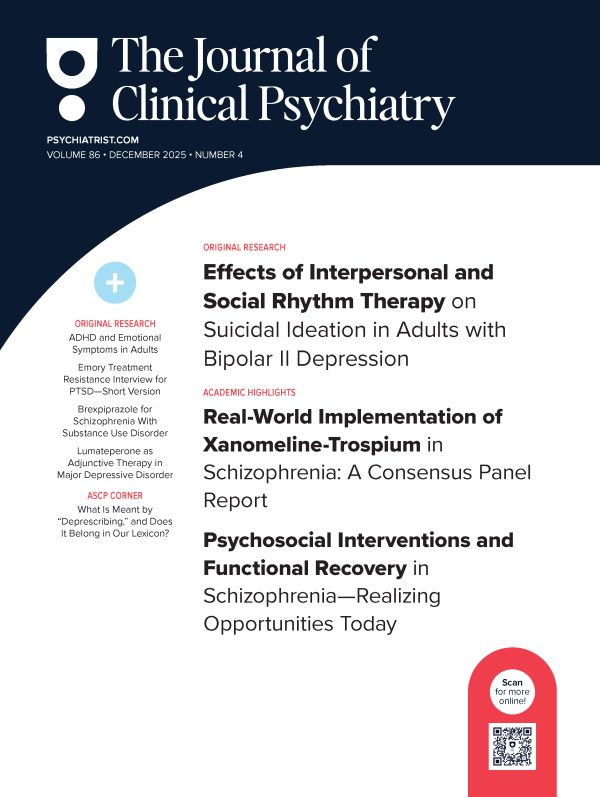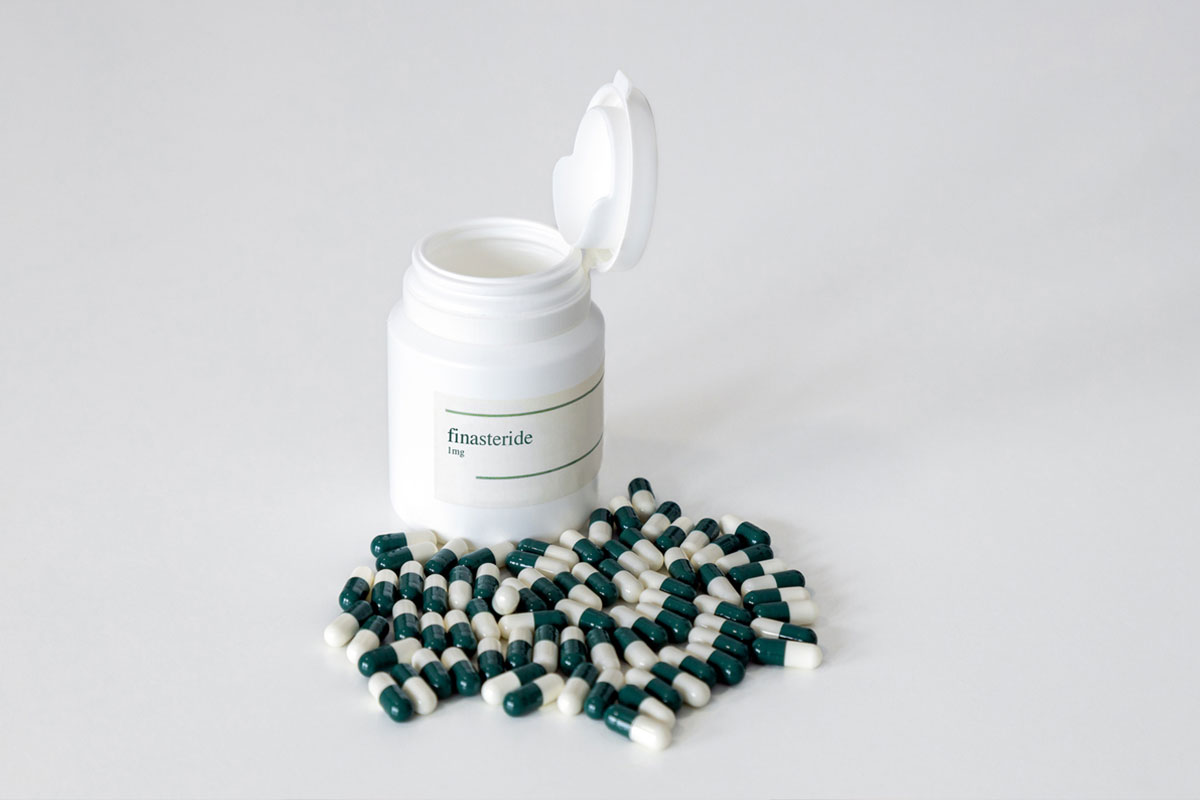Abstract
Objective: The aim of this study was to identify sleep/wake characteristics associated with suicidal ideation (SI) severity among older adults who are at risk for suicide.
Methods: This 6-week observational study examined associations between weekly actigraphy-derived sleep/wake measures and SI severity (Beck Scale for Suicidal Ideation [SSI]). The sample (n = 30; 83% female; average age = 62 years), enrolled April 2021 through March 2023, self reported a physician diagnosis of DSM-5 major depressive disorder with an episode in the last 6 months and also had either recent active SI or a past suicide attempt. Weekly sleep/wake measures included sleep duration, fragmentation, and 2 rhythm variables (interdaily stability and relative amplitude). Primary analyses used age- and sex-adjusted repeated-measure linear mixed models, 1 model per sleep/wake variable, to assess associations between weekly sleep/ wake and SI reported at week’s end. We examined if associations of sleep/wake factors with SI were independent of depression severity (Patient Health Questionnaire-8 scores).
Results: Longer sleep duration, greater interdaily stability, and higher relative amplitude were associated with lower SI (eg, for each standard deviation higher interdaily stability, SSI scores were an estimated 1.4 points lower [P = .005]). After adjusting for depression severity, both sleep/wake rhythm variables remained significantly associated with SI, whereas the association between sleep duration and SI severity was attenuated by >80%.
Conclusion: In this sample, sleep/wake rhythm disruption (but not sleep duration or fragmentation) related to SI independent of depression severity. Targeting disruptions in sleep/wake rhythms may be an important avenue for future trials of sleep medicine approaches to reduce SI in older adults.
J Clin Psychiatry 2025;86(3):24m15522
Author affiliations are listed at the end of this article.
Members Only Content
This full article is available exclusively to Professional tier members. Subscribe now to unlock the HTML version and gain unlimited access to our entire library plus all PDFs. If you’re already a subscriber, please log in below to continue reading.
References (66)

- Poole L, Steptoe A. Depressive symptoms predict incident chronic disease burden 10 years later: findings from the English Longitudinal Study of Ageing (ELSA). J Psychosom Res. 2018;113:30–36. PubMed CrossRef
- Van der Kooy K, van Hout H, Marwijk H, et al. Depression and the risk for cardiovascular diseases: systematic review and meta analysis. Int J Geriatr Psychiatry. 2007;22(7):613–626. PubMed CrossRef
- Mezuk B, Eaton WW, Albrecht S, et al. Depression and type 2 diabetes over the lifespan: a meta-analysis. Diabetes Care. 2008;31(12):2383–2390. PubMed CrossRef
- Meeks TW, Vahia IV, Lavretsky H, et al. A tune in “A minor” can “B major”: a review of epidemiology, illness course, and public health implications of subthreshold depression in older adults. J Affect Disord. 2011;129(1–3):126–142. PubMed CrossRef
- Penninx BW, Guralnik JM, Ferrucci L, et al. Depressive symptoms and physical decline in community-dwelling older persons. JAMA. 1998;279(21):1720–1726. PubMed CrossRef
- GBD 2019 Diseases and Injuries Collaborators, Lim SS, Abbafati C, et al. Global burden of 369 diseases and injuries in 204 countries and territories, 1990–2019: a systematic analysis for the Global Burden of Disease Study 2019. Lancet. 2020;396(10258):1204–1222. PubMed CrossRef
- GBD 2019 Mental Disorders Collaborators. Global, regional, and national burden of 12 mental disorders in 204 countries and territories, 1990-2019: a systematic analysis for the Global Burden of Disease Study 2019. Lancet Psychiatry. 2022;9(2):137–150. PubMed CrossRef
- Ribeiro JD, Huang X, Fox KR, et al. Depression and hopelessness as risk factors for suicide ideation, attempts and death: meta-analysis of longitudinal studies. Br J Psychiatry. 2018;212(5):279–286. PubMed CrossRef
- Rossom RC, Coleman KJ, Ahmedani BK, et al. Suicidal ideation reported on the PHQ9 and risk of suicidal behavior across age groups. J Affect Disord. 2017;215:77–84. PubMed CrossRef
- Kuo WH, Gallo JJ, Tien AY. Incidence of suicide ideation and attempts in adults: the 13-year follow-up of a community sample in Baltimore, Maryland. Psychol Med. 2001;31(7):1181–1191. PubMed CrossRef
- Bernert, RA, Joiner TE. Sleep disturbances and suicide risk: a review of the literature. Neuropsychiatr Dis Treat. 2007;3(6):735–743. PubMed CrossRef
- Norra C, Richter N, Juckel G. Sleep disturbances and suicidality: a common association to look for in clinical practise and preventive care. EPMA J. 2011;2(3):295–307. PubMed CrossRef
- McCall WV, Black CG. The link between suicide and insomnia: theoretical mechanisms. Curr Psychiatry Rep. 2013;15(9):389. PubMed CrossRef
- Perlis ML, Grandner MA, Chakravorty S, et al. Suicide and sleep: is it a bad thing to be awake when reason sleeps? Sleep Med Rev. 2016;29:101–107. PubMed CrossRef
- Bernert RA, Kim JS, Iwata NG, et al. Sleep disturbances as an evidence-based suicide risk factor. Curr Psychiatry Rep. 2015;17(3):554. PubMed CrossRef
- Woznica AA, Carney CE, Kuo JR, et al. The insomnia and suicide link: toward an enhanced understanding of this relationship. Sleep Med Rev. 2015;22:37–46. PubMed CrossRef
- Rumble ME, Dickson D, McCall WV, et al. The relationship of person-specific eveningness chronotype, greater seasonality, and less rhythmicity to suicidal behavior: a literature review. J Affect Disord. 2018;227:721–730. PubMed CrossRef
- Pigeon WR, Pinquart M, Conner K. Meta-analysis of sleep disturbance and suicidal thoughts and behaviors. J Clin Psychiatry. 2012;73(9):e1160–e1167. PubMed CrossRef
- Malik S, Kanwar A, Sim LA, et al. The association between sleep disturbances and suicidal behaviors in patients with psychiatric diagnoses: a systematic review and meta-analysis. Syst Rev. 2014;3:18. PubMed CrossRef
- Romier A, Maruani J, Lopez-Castroman J, et al. Objective sleep markers of suicidal behaviors in patients with psychiatric disorders: a systematic review and meta-analysis. Sleep Med Rev. 2023;68:101760. PubMed CrossRef
- Walsh RFL, Maddox MA, Smith LT, et al. Social and circadian rhythm dysregulation and suicide: a systematic review and meta-analysis. Neurosci Biobehav Rev. 2024;158:105560. PubMed CrossRef
- Ağargün MY, Kara H, Solmaz M. Subjective sleep quality and suicidality in patients with major depression. J Psychiatr Res. 1997;31(3):377–381. PubMed CrossRef
- Bernert RA, Turvey CL, Conwell Y, et al. Association of poor subjective sleep quality with risk for death by suicide during a 10-year period: a longitudinal, population-based study of late life. JAMA Psychiatry. 2014;71(10):1129–1137. PubMed CrossRef
- Fawcett J, Scheftner WA, Fogg L, et al. Time-related predictors of suicide in major affective disorder. Am J Psychiatry. 1990;147(9):1189–1194. PubMed CrossRef
- Ribeiro JD, Pease JL, Gutierrez PM, et al. Sleep problems outperform depression and hopelessness as cross-sectional and longitudinal predictors of suicidal ideation and behavior in young adults in the military. J Affect Disord. 2012;136(3):743–750. PubMed CrossRef
- Ağargün MY, Kara H, Solmaz M. Sleep disturbances and suicidal behavior in patients with major depression. J Clin Psychiatry. 1997;58(6):249–251. PubMed
- Kim J-H, Park E-C, Cho W-H, et al. Association between total sleep duration and suicidal ideation among the Korean general adult population. Sleep. 2013;36(10):1563–1572. PubMed CrossRef
- Perlis ML, Grandner MA, Brown GK, et al. Nocturnal wakefulness as a previously unrecognized risk factor for suicide. J Clin Psychiatry. 2016;77(6):e726–e733. PubMed CrossRef
- Ballard ED, Vande Voort JL, Bernert RA, et al. Nocturnal wakefulness is associated with next-day suicidal ideation in major depressive disorder and bipolar disorder. J Clin Psychiatry. 2016;77(6):825–831. PubMed CrossRef
- Bernert RA, Hom MA, Iwata NG, et al. Objectively assessed sleep variability as an acute warning sign of suicidal ideation in a longitudinal evaluation of young adults at high suicide risk. J Clin Psychiatry. 2017;78(6):e678–e687. PubMed CrossRef
- Verkes RJ, Kerkhof GA, Beld E, et al. Suicidality, circadian activity rhythms and platelet serotonergic measures in patients with recurrent suicidal behaviour. Acta Psychiatr Scand. 1996;93(1):27–34. PubMed CrossRef
- Indic P, Murray G, Maggini C, et al. Multi-scale motility amplitude associated with suicidal thoughts in major depression. PloS One. 2012;7(6):e38761. PubMed CrossRef
- Salvatore P, Indic P, Khalsa HK, et al. Circadian activity rhythms and psychopathology in major depressive episodes. Psychopathology. 2024;57(1):1–9. PubMed CrossRef
- Aronen ET, Simola P, Soininen M. Motor activity in depressed children. J Affect Disord. 2011;133(1–2):188–196. PubMed CrossRef
- Kivelä LMM, van der Does W, Antypa N. Sleep, hopelessness, and suicidal ideation: an ecological momentary assessment and actigraphy study. J Psychiatr Res. 2024;177:46–52. PubMed CrossRef
- Benard V, Etain B, Vaiva G, et al. Sleep and circadian rhythms as possible trait markers of suicide attempt in bipolar disorders: an actigraphy study. J Affect Disord. 2019;244:1–8. PubMed CrossRef
- Rumble ME, McCall WV, Dickson DA, et al. An exploratory analysis of the association of circadian rhythm dysregulation and insomnia with suicidal ideation over the course of treatment in individuals with depression, insomnia, and suicidal ideation. J Clin Sleep Med. 2020;16(8):1311–1319. PubMed CrossRef
- de Feijter M, Kocevska D, Ikram MA, et al. The bidirectional association of 24-h activity rhythms and sleep with depressive symptoms in middle-aged and elderly persons. Psychol Med. 2021:1–8. CrossRef
- Smagula SF, Boudreau RM, Stone K, et al. Latent activity rhythm disturbance sub groups and longitudinal change in depression symptoms among older men. Chronobiol Int. 2015;32(10):1427–1437. PubMed CrossRef
- Pye J, Phillips AJK, Cain SW, et al. Irregular sleep-wake patterns in older adults with current or remitted depression. J Affect Disord. 2021;281:431–437. PubMed CrossRef
- Beck AT, Kovacs M, Weissman A. Assessment of suicidal intention: the Scale for Suicide Ideation. J Consult Clin Psychol. 1979;47(2):343–352. PubMed CrossRef
- Kroenke K, Spitzer RL, Williams JBW. The PHQ-9: validity of a Brief Depression Severity Measure. J Gen Intern Med. 2001;16(9):606–613. PubMed CrossRef
- Bastien CH, Vallières A, Morin CM. Validation of the Insomnia Severity Index as an outcome measure for insomnia research. Sleep Med. 2001;2(4):297–307. PubMed CrossRef
- Dean DA 2nd, Goldberger AL, Mueller R, et al. Scaling up scientific discovery in sleep medicine: the National Sleep Research Resource. Sleep. 2016;39(5):1151–1164. PubMed CrossRef
- Patel SR, Weng J, Rueschman M, et al. Reproducibility of a standardized actigraphy scoring algorithm for sleep in a US Hispanic/Latino population. Sleep. 2015;38(9):1497–1503. PubMed CrossRef
- Suibkitwanchai K, Sykulski AM, Perez Algorta G, et al. Nonparametric time series summary statistics for high-frequency accelerometry data from individuals with advanced dementia. PLoS One. 2020;15(9):e0239368–e0239368. PubMed CrossRef
- Gonçalves BSB, Adamowicz T, Louzada FM, et al. A fresh look at the use of nonparametric analysis in actimetry. Sleep Med Rev. 2015;20:84–91. PubMed
- Brown GK, Beck AT, Steer RA, et al. Risk factors for suicide in psychiatric outpatients: a 20-year prospective study. J Consult Clin Psychol. 2000;68(3):371–377. PubMed CrossRef
- Levis B, Benedetti A, Thombs BD, et al. Accuracy of Patient Health Questionnaire 9 (PHQ-9) for screening to detect major depression: individual participant data meta-analysis. BMJ Clin Res ed. 2019;365:l1476. PubMed CrossRef
- Morin CM, Belleville G, Bélanger L, et al. The Insomnia Severity Index: psychometric indicators to detect insomnia cases and evaluate treatment response. Sleep. 2011;34(5):601–608. PubMed CrossRef
- Smagula SF, Ancoli-Israel S, Blackwell T, et al. Circadian rest-activity rhythms predict future increases in depressive symptoms among community-dwelling older men. Am J Geriatr Psychiatry. 2015;23(5):495–505. PubMed CrossRef
- Kang SJ, Leroux A, Guo W, et al. Integrative modeling of accelerometry-derived sleep, physical activity, and circadian rhythm domains with current or remitted major depression. JAMA Psychiatry. 2024;81(9):911–918. PubMed CrossRef
- Lyall LM, Wyse CA, Graham N, et al. Association of disrupted circadian rhythmicity with mood disorders, subjective wellbeing, and cognitive function: a cross sectional study of 91 105 participants from the UK Biobank. Lancet Psychiatry. 2018;5(6):507–514. PubMed CrossRef
- Manber R, Bernert RA, Suh S, et al. CBT for insomnia in patients with high and low depressive symptom severity: adherence and clinical outcomes. J Clin Sleep Med. 2011;7(6):645–652. PubMed CrossRef
- Trockel M, Karlin BE, Taylor CB, et al. Effects of cognitive behavioral therapy for insomnia on suicidal ideation in veterans. Sleep. 2015;38(2):259–265. PubMed CrossRef
- Pigeon WR, Funderburk JS, Cross W, et al. Brief CBT for insomnia delivered in primary care to patients endorsing suicidal ideation: a proof-of-concept randomized clinical trial. Transl Behav Med. 2019;9(6):1169–1177. PubMed CrossRef
- McCall WV, Benca RM, Rosenquist PB, et al. Reducing Suicidal Ideation Through Insomnia Treatment (REST-IT): a randomized clinical trial. Am J Psychiatry. 2019;176(11):957–965. PubMed CrossRef
- Brundin L, Bryleva EY, Thirtamara Rajamani K. Role of inflammation in suicide: from mechanisms to treatment. Neuropsychopharmacology. 2017;42(1):271–283. PubMed CrossRef
- Vasupanrajit A, Jirakran K, Tunvirachaisakul C, et al. Inflammation and nitro oxidative stress in current suicidal attempts and current suicidal ideation: a systematic review and meta-analysis. Mol Psychiatry. 2022;27(3):1350–1361. PubMed CrossRef
- Kiosses DN, Szanto K, Alexopoulos GS. Suicide in older adults: the role of emotions and cognition. Curr Psychiatry Rep. 2014;16(11):495. PubMed CrossRef
- Xiao Q, Qian J, Evans DS, et al. Cross-Sectional and prospective associations of rest-activity rhythms with circulating inflammatory markers in older men. J Gerontol A Biol Sci Med Sci. 2022;77(1):55–65. PubMed CrossRef
- Smagula SF, Gujral S, Capps CS, et al. A systematic review of evidence for a role of rest-activity rhythms in dementia. Front Psychiatry. 2019;10:778. PubMed CrossRef
- Chellappa SL, Morris CJ, Scheer FAJL. Circadian misalignment increases mood vulnerability in simulated shift work. Sci Rep. 2020;10(1):18614. PubMed CrossRef
- Groeger JA, Lo JC-Y, Santhi N, et al. Contrasting effects of sleep restriction, total sleep deprivation, and sleep timing on positive and negative affect. Front Behav Neurosci. 2022;16:911994. PubMed CrossRef
- Harvey AG, Hein K, Dong L, et al. A transdiagnostic sleep and circadian treatment to improve severe mental illness outcomes in a community setting: study protocol for a randomized controlled trial. Trials. 2016;17(1):606. PubMed CrossRef
- Smagula SF, Gasperetti CE, Buysse DJ, et al. Efficacy of the transdiagnostic intervention for sleep and circadian dysfunction for depression symptoms and sleep-wake disruption in older and younger adults: secondary age-stratified analysis of a randomized controlled trial. Am J Geriatr Psychiatry. 2024;32(4):478–488. PubMed CrossRef






